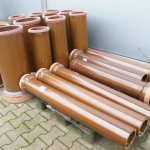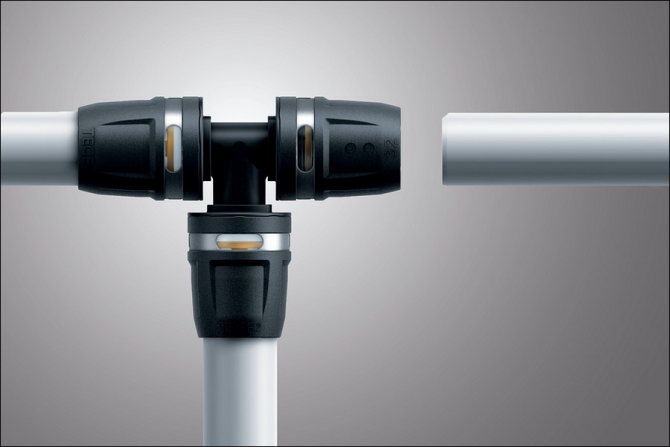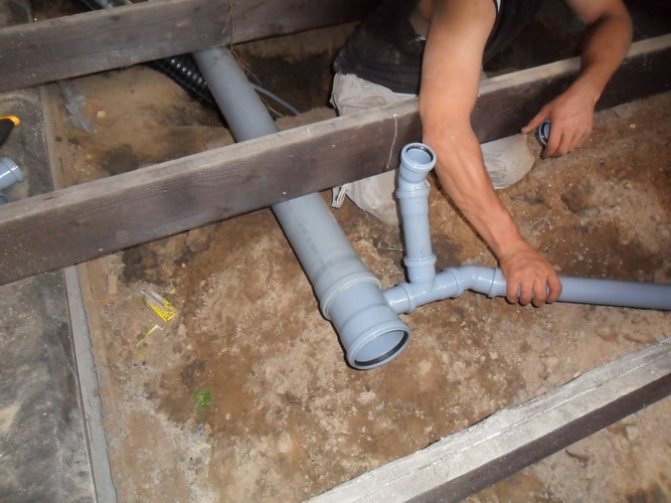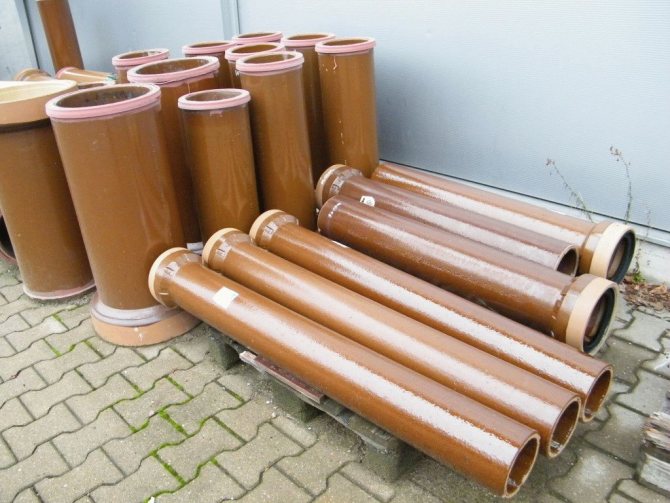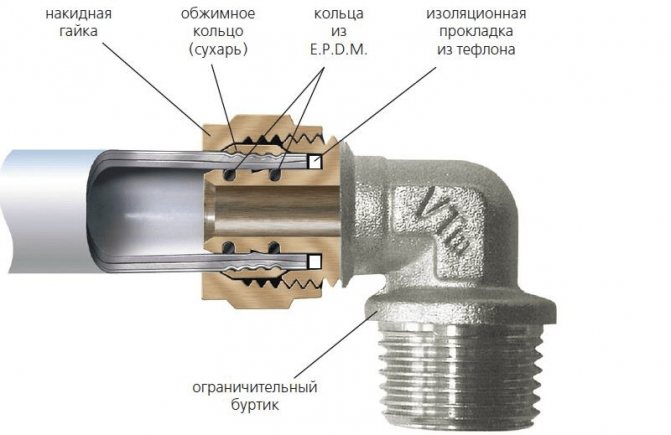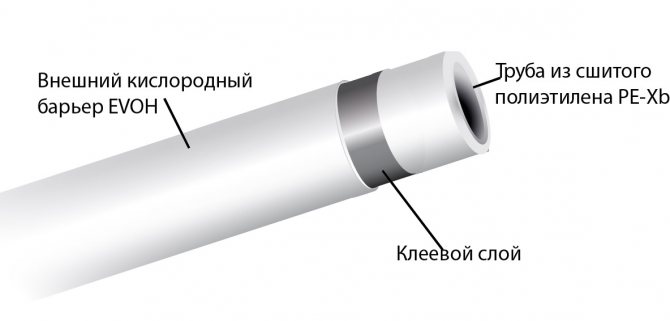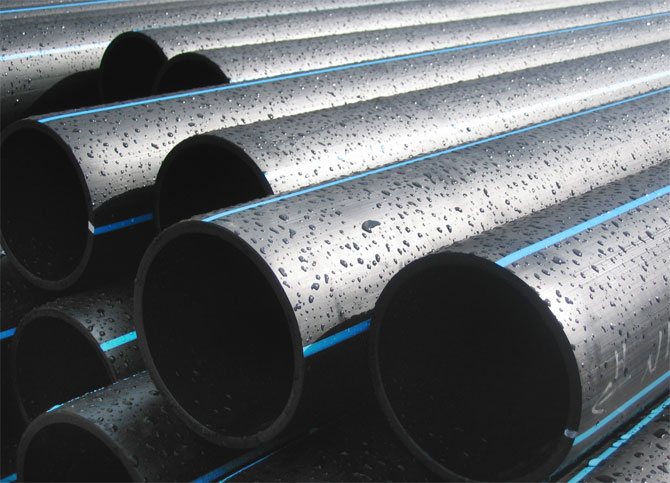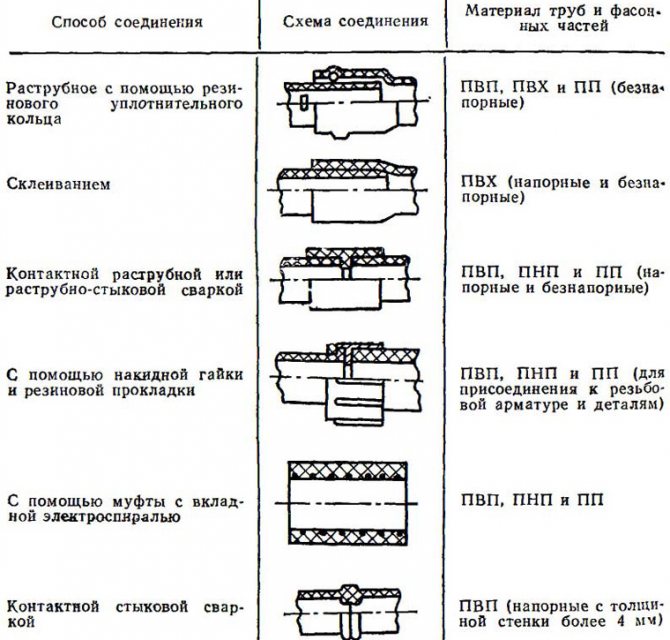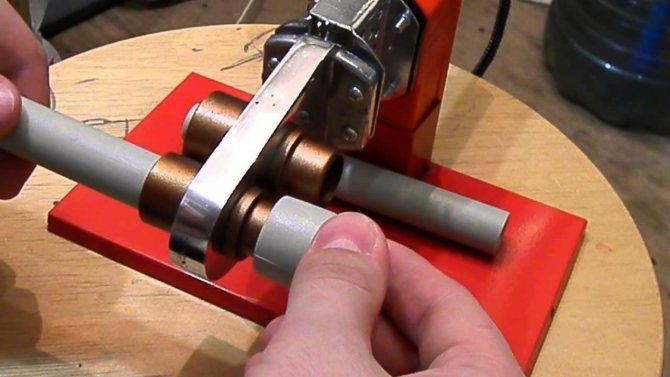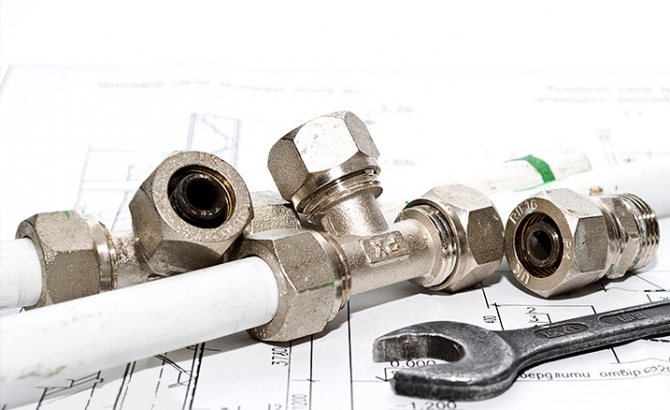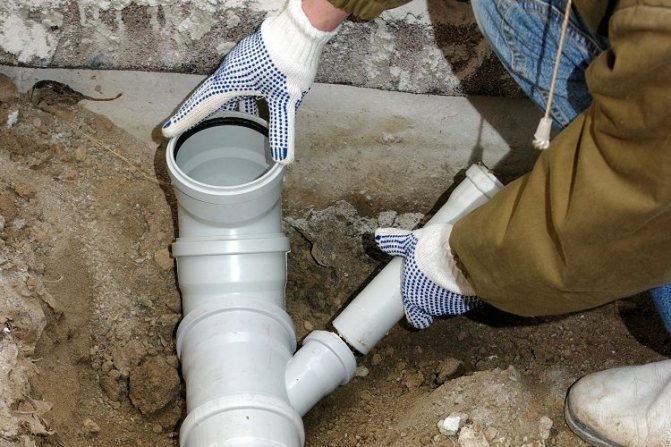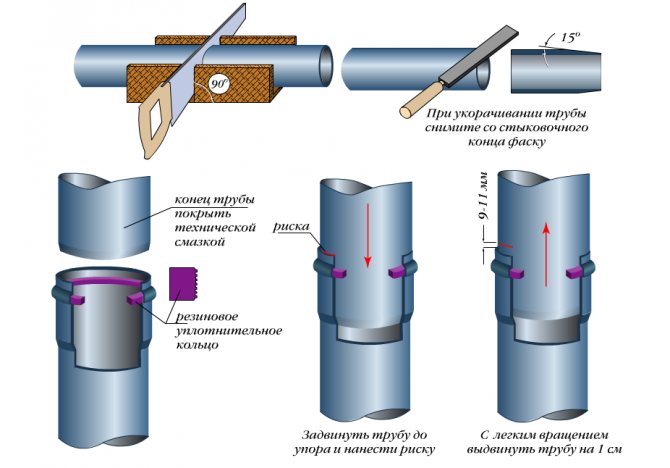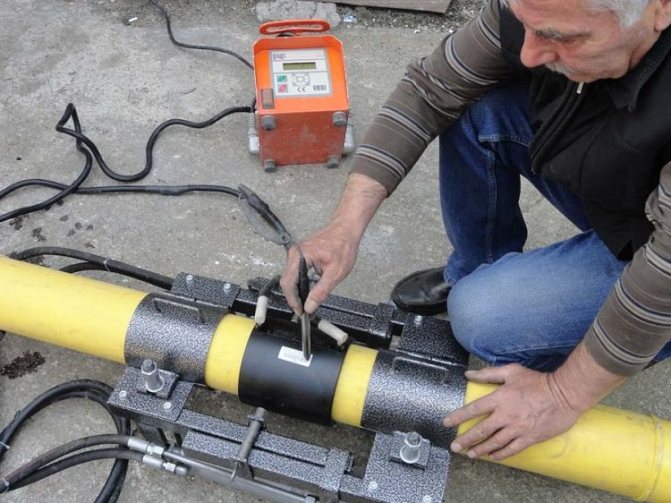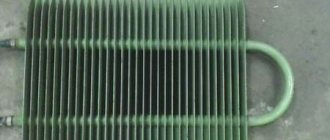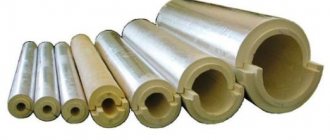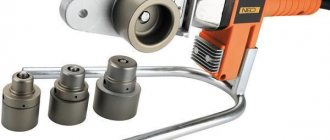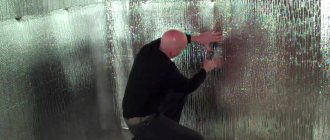- Types of sewer pipes and their features
- Connection angle
- Preparing for the process
- We work with plastic pipes: the "in the socket" method
- How to join with an adhesive base or a weld
- How to connect a toilet
- Working with cast iron and ceramic pipes
- We connect a new toilet to a cast iron pipe
Sooner or later, any owner will have to replace the pipes. Since the procedure requires considerable costs, in order to save money, it can be carried out without the involvement of hired workers. But for this you need to know how to connect the sewer pipes.
Since types of pipes made of various materials are used in construction, in order to choose the correct connection method, it is necessary to take into account which of them the product belongs to.
Types of sewer pipes and their features
When installing, you need to take into account all the properties of the selected material in order to correctly choose the method of fastening and calculate your strength.
In modern construction, the following types are most common:
- Metallic. The most commonly used metals are steel or cast iron. The first option has a number of advantages, it is durable and can withstand fairly high temperatures. Despite this, due to its increased tendency to corrosion, it is used less and less.
But cast iron is not inferior to positions. Being more expensive than steel products, cast iron pipes are undoubtedly better in service. Their ability to resist corrosion combined with their long service life is highly valued. But when assembling, you need to consider:
- installation is very difficult to do with your own hands;
- a large mass creates a lot of difficulties in work;
- the price category makes the purchase costly.

Ceramic pipes for sewerage
- Ceramic. Such materials are used in a wide variety of areas, including sewerage. Such products are mounted according to the same principle as the previous ones, but the lower weight makes it easier to carry out the work.
- Plastic. PVC products are quite versatile, since they have the following properties:
- strength;
- ease of installation work;
- affordable price category.
Products made from propylene have great advantages and increased strength, therefore it is preferable to use them. In addition, at home, the easiest way is to assemble the desired structure using a similar material.
Classification
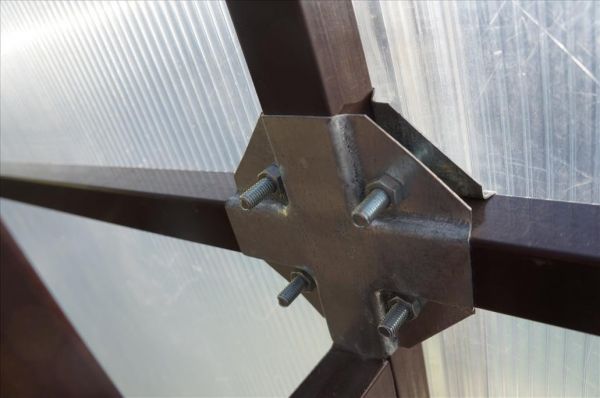

Dismountable connection of profile pipes with bolts during the construction of a greenhouse
All water pipes, in accordance with the production materials used in their manufacture, are divided into the following categories:
- metal modifications;
- polymer modifications;
- metal-plastic products.
Important: Each of these modifications is represented on the market by a wide range of products, which are characterized by one or another method of connection. Therefore, when planning the installation of a water supply system in your apartment or a country house, you need to take the utmost responsibility to the choice of materials and connection methods, since the price, durability and appearance of the finished system largely depend on this.
So, let's look at how the mixer is connected to the pipe independently.
Docking metal pipes


Threaded connection on a steel water pipe
During the installation of metal (cast iron, steel and copper) plumbing and heating systems, threaded and welded joints are used.
Let's take a closer look at each of these methods:
- Threaded installation, by the way, also includes the connection of pipes by an American, this is a technology that allows you to assemble water pipes from elements with the same cross-sectional diameters.
To do this, a thread is cut at the ends of both pipes, over which a special metal sleeve is screwed - a fitting. By means of special fittings, both straight and curved plumbing and heating systems can be assembled.
The fitting used on such structures has an internal thread, while an external thread is cut on the pipes. If the fittings for installation are purchased with already cut threads, then you will have to cut them on the joined elements with your own hands using dies.
Among the advantages of the technology, we note the strength and durability of the finished result. In addition, the threaded fitting, if necessary, can be unscrewed and the entire structure can be disassembled in order to eliminate the damage or remake.
Important: Typically, the threads on pipes and fittings are standard. But if accessories of foreign production are purchased from little-known brands, you need to make sure that the product will correspond to the metric type of thread.
- Installation of plumbing systems using welding is rarely used. The main disadvantage of a welded joint is the impossibility of making it with your own hands, since a professional welder with special equipment and experience in using this equipment can cope with such work.
For the installation of two one-size pipes, the following types of welded joints are used:
- transverse butt (without boring or with internal boring) with a backing ring;
- longitudinal butt (without bevel or bevel) with one-sided seam;
- transverse butt joint with one-sided seam;
- one-sided corner;
- double-sided corner;
- socket overlap.
The butt joint is the most common, since the finished result is characterized by high strength, provided that the abutting elements are correctly centered.
If a water supply system with an inner diameter of up to 500 mm is assembled, a one-sided seam is cooked, the strength of which is quite sufficient. If the diameter is larger, the root of the seam is welded from the inside, as a result of which the strength of the joint increases.
The welded seam is considered the optimal type of connection for the installation of industrial water supply systems, but in everyday life it is used extremely rarely due to the high cost of the finished version and the cramped conditions for using the welding machine.
Soldering copper components is a technology used in the assembly of premium plumbing systems.
The installation principle is as follows:
- the ends of the abutting elements are cleaned and covered with solder;
- the inner surface of the fitting is cleaned and covered with solder;
- the pipe is inserted into the fitting and heated by the burner;
- after the solder cools down, a strong and durable sleeve joint is obtained.
Types of connection of polymer products
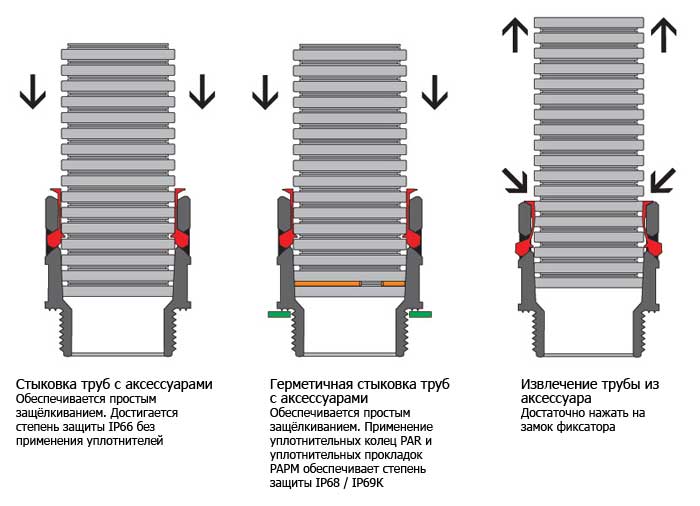

In the diagram, the phased connection of corrugated pipes
If the question is how to connect HDPE pipes, then in this case the installation is an order of magnitude easier than assembling a metal water supply system. No threads are cut on plastic, and installation is carried out in two ways: by soldering or using fittings.
- The connection of HDPE pipes using fittings is popular in the assembly of domestic water supply and sewerage systems. The relevance of the method is not surprising, since fittings, regardless of modification, can be installed even by a novice plumber.
Fittings, according to their design features, are divided into the following categories:
- Crimp modifications - simple, yet effective and versatile mounting accessories. For installation, special pliers are used to evenly distribute the applied force along the entire perimeter of the crimp sleeve.
- Press fittings - are distinguished by the greatest reliability, since they guarantee the complete absence of leaks.
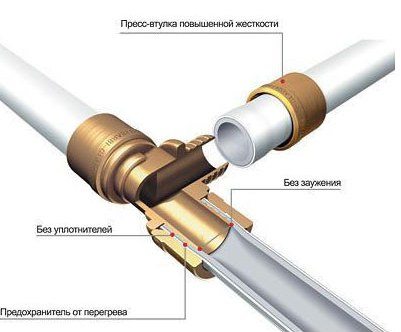

The figure shows the connection of PVC pipes using crimp fittings
Installation is carried out using a special apparatus. Fittings of this type are installed, first of all, for the installation of a water supply system, followed by embedding into a wall or floor screed.
- Push fittings - this is the best solution if ease of installation is required. Connecting elements are used so that during operation it was possible to disassemble the structure.
- Welded connection of propylene pipes using special equipment is performed butt-weld or with the use of plastic fittings.
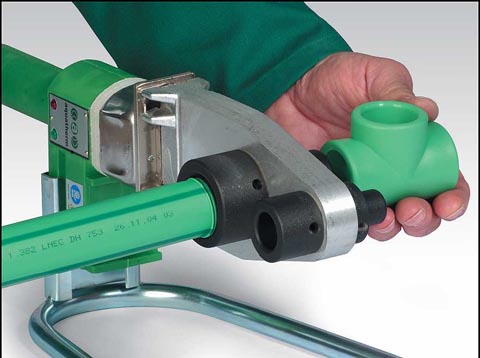

In the photo - welding using a hand-held soldering iron
Butt welding is relevant when the installation of large-diameter water supply and sewer systems is carried out. For another type of welding, an electrofusion sleeve or special fittings are used.
In either case, the surfaces to be joined melt, and as the plastic cools down, a reliable almost monolithic joint is formed.
Installation of metal-plastic water pipelines


Push-in fitting with swivel nut
Docking of metal-plastic pipes is carried out using the following connecting elements:
- Collet compression detachable fittings - during installation, they are inserted into the hole with a shank, pulled together with a collet and fixed with a union nut. The shank of the connecting element is equipped with rubber O-rings, which are crimped by the squeezed pipe and provide the required level of tightness.
- One-piece press fittings are a disposable docking accessory. The fitting shank, equipped with O-rings, is inserted into the pipe until it stops. Then, using special pliers, a flexible cuff is crimped, which acts as a union nut.
Connection angle
Regardless of which option you prefer, some of the preparation steps will remain the same. First of all, keep in mind that it is recommended to lay the sewage system not in one horizontal line, but with a slight angle of inclination. So it will function better, therefore it is necessary that the angle of inclination of the installed system is at least 0.02.
If the amount of available wastewater is small, this indicator needs to be increased to 0.03. Basically, this means that for every meter, the difference between the level of the ends should be exactly 3 cm.But make sure not to make a too large angle, otherwise the water will drain, leaving dirt.
Preparing for the process
Before proceeding directly to the installation, pay attention to some of the nuances that the technology requires:
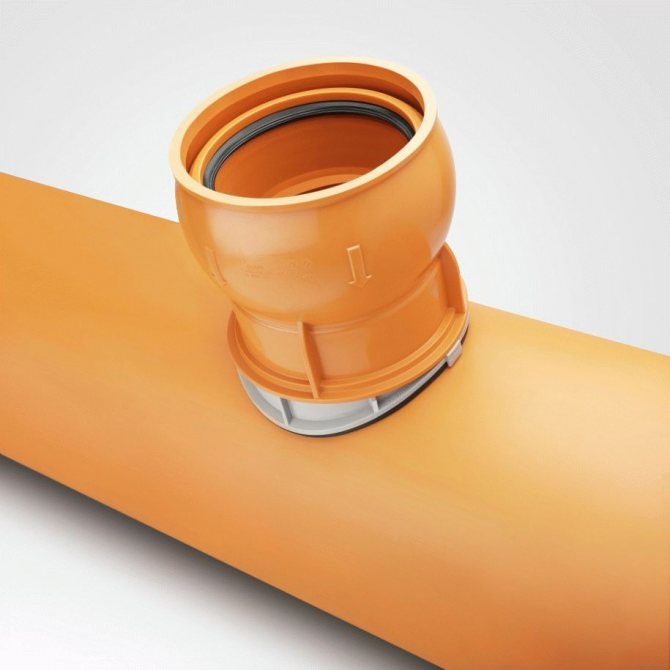

Sewage pipe
- make sure to purchase a sufficient amount of materials and related products;
- make a plan according to which you will place the sewer system;
- mark up and start cutting;
- the places where the cuts were made should be cleaned in order to facilitate further work, so clean them from burrs.
Get serious about making a plan, mistakes made will be difficult, and sometimes almost impossible to fix. Do not forget that in private construction and in multi-storey buildings, products of 50 or 110 mm Ø are usually used. At the same time, it is worth taking into account how much equipment you intend to connect.
We work with plastic pipes: the "in the socket" method
If you are thinking about how to connect sewer plastic pipes, several methods will come in handy. The process is easy enough due to the properties of the material, but there are many ways to make connections.
One of them is the flared version. A similar principle is used in children's construction sets. So you can easily assemble almost any equipment. The following instruction will come in handy:
- Clean both the bell end and the spigot end.
- Check for the presence of the seal. This rubber product is designed to ensure tightness.
- Take silicone grease. She needs to spread the smooth part.
- Insert the corresponding part into the socket.

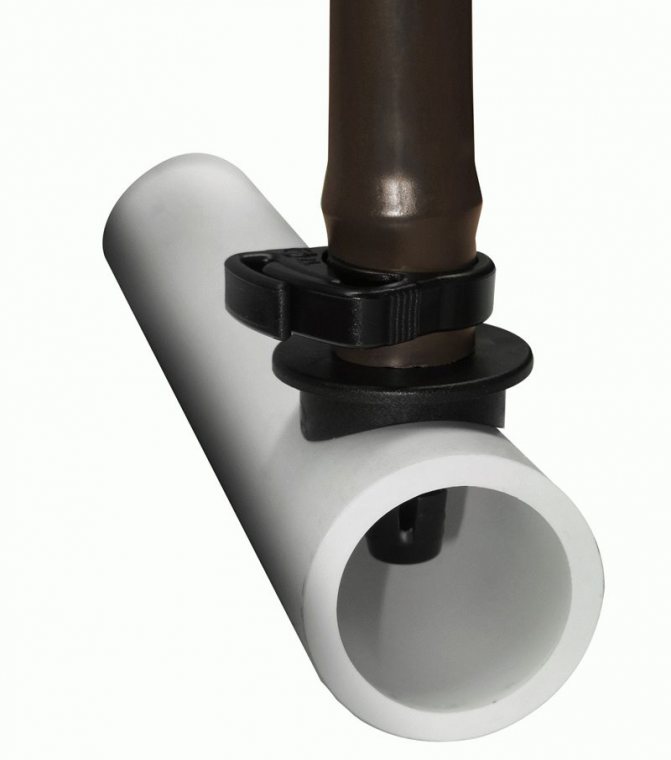
Installation of a plastic pipe for sewage
- Make a mark to mark the injection level.
- Pull the pipe back and slide it out about 1 cm, making sure it goes through the existing seal.
Consider the direction of the future flow, the socket should be located along its course. This method is suitable only for the installation of certain networks, namely gravity.
Pay attention that there are no defects on the surfaces. Sometimes products have deep, large scratches that need to be carefully sanded down with a knife. If you are making a connection to a fitting, there is a possibility that it will have large solder seams. They also need to be removed, otherwise the connection will definitely be loose.
Sometimes the hot method is used. For example, there is no socket on your material, and you need to make a connection. In such a case, you can use a soldering machine and warm up the desired area by gently twisting it. Then connect the pipes in a smooth motion. Sometimes a construction hair dryer is also used. True, this method should not be used when you are mounting the system horizontally.
Detachable sewer pipe connections
Detachable connections are applicable to form a communication system directly inside the apartments. This method does not require any chemical or thermal effects and is elementary simple to carry out. It is also called clutch. In addition, it allows you to quickly detect and eliminate system malfunctions, since the docking points are easily disassembled.
For joining two pipes, the technology provides for special parts to ensure a reliable and tight fit. There are two types of such connections: fitting and flanged. The effectiveness of such connections is due to the presence of rubber seals. It should be noted that a flange connection is practically indispensable for the connection of pipes made of different materials of large cross-section, and fittings - for a smaller one, one that is optimal for living quarters.
Sewer fittings are divided into two types: compression and cast.
Different parts are used for different purposes.
1. The reducer is used to connect pipes with different diameters. 2. Straight coupler is used to connect pipes of the same cross-section. 3. Tees are needed for the installation of branches in the sewer system. 4. The cross piece is designed to cross-connect the pipeline.
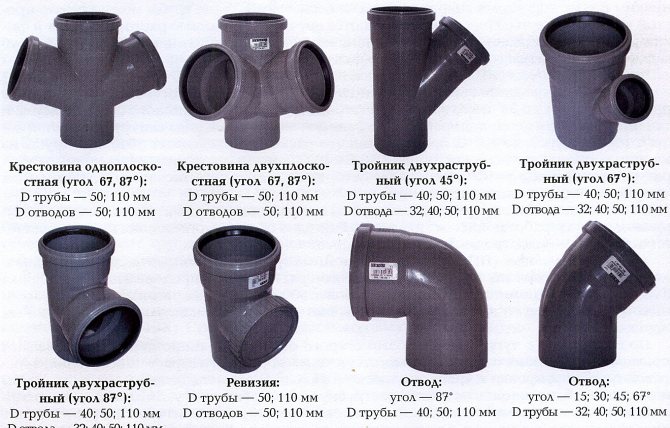

And many other varieties such as plugs, saddles, flange adapters, and so on.
Attention! Use silicone grease to make it easier for the pipe to slide into the fitting. Grease is not permitted when used with rubber seals.
Adhesive bonding
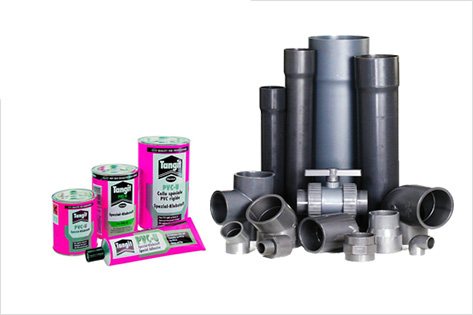

Glue connection is carried out by applying special glue to the cuts of both ends of PVC pipes. This adhesive is based on methylene chloride, the effectiveness of which is based on the dissolution of plastic and subsequent bonding at the molecular level.This method is good in that it does not require any special devices, in addition to the standard set of tools.
Attention! The glue contains volatile substances, so the estimated time between glue application and the splicing of parts should be short enough and not more than one and a half minutes.
Coupling method of gluing
- The pipe cut of a smaller diameter is cleaned and degreased from the outside.
- The socket must also be degreased from the inside.
- A layer of glue is applied to the parts to be fastened.
- We articulate the knot by inserting the pipe into the socket.
- Leave until the glue hardens completely.
Attention! Before connecting plastic sewer pipes with glue or welding methods, degrease the joint surface, this will improve the adhesion of the particles.
Back to content
How to join with an adhesive base or a weld
It is easy to make such an installation if you use the glue intended for this. Clean the surfaces to be connected in the same way, not forgetting to degrease. After that, apply glue, connect the pipes and hold for about 1 minute. This period of time will be enough for the glue used to set.
In conclusion, achieve complete tightness by applying an additional layer of glue for this purpose so that it covers your joint and forms a small bead on it.


Connection of plastic pipes
The weld seam method is often used. If you doubt how to connect PVC sewer pipes, but at the same time you have an apparatus that allows you to carry out welding work on such a material as plastic, the following method will come in handy:
- heat the ends until you notice that the ends are gradually melting (this usually takes a few seconds);
- press the ends and fix them in the desired position until the plastic is sufficiently cooled and set.
You will get the strongest connection, which, if done correctly, will be monolithic.
It should be noted that the purchase or rental of such a device is justified when you are constantly doing such work. In the case when you have to carry out only installation in your own apartment, it is better to give preference to fittings. Do not forget to also use rubber gaskets, and optionally - silicone.
How to connect plastic water pipes?
Hello dear reader! In our houses and apartments, you can most often see the wiring of communal systems made of different types of plastic. They owe such popularity to their low price along with high performance properties.
The connection of plastic pipes can be done in different ways. Which one is more suitable for each of the types of plastic pipes, I want to tell you in this article.
Pros and cons of plastic pipes
The advantages of using plastic pipes for assembling water supply pipelines are due to them:
- Absolute corrosion resistance.
- High cross-country ability.
- Light weight. They are easier to transport and install.
- Resistant to acids and other aggressive media.
- Elasticity, thanks to which communications do not break when water freezes.
- Environmental friendliness. Plastic is safe for human health.
- Soundproofing property.
- Low electrical conductivity.
- High manufacturability. Plastic pipes cut well. They fit well on the end, connection with fittings or soldering is easy.
- Affordable cost.
- Durability. Plastic pipes, depending on the type, can be used from 20 to 50 years.
- Attractive appearance.
The disadvantages include:
- Low fire resistance.
- Intolerance to exposure to direct sunlight.
- Not suitable for high pressure systems.
- Loss of strength under shock loads.
Types of plastic pipes
The group of plastic pipes includes a wide range of products.They differ in the composition and proportions of raw materials, in the structure of the wall, and in technical characteristics. Plastic pipes are of the following types:
- Polypropylene (PP). They are versatile products that are resistant to cold and hot water. They are made in lengths of 4 m and a diameter of 16 to 125 mm, they can be operated under a pressure of 10, 16, 20 atmospheres. They can be gray, white, black or green. They are produced in two versions - single-layer and with multi-layer wall construction. Single-layer pipes are flexible and soft, therefore they are used only for the assembly of low-pressure cold water supply systems or for underfloor heating. Polypropylene pipes reinforced with fiberglass or aluminum are rigid and have a low coefficient of linear expansion. They are more durable and resistant to pressure overload. These properties make it possible to use them in heating systems, hot water supply, drinking water supply.
- Polyvinyl chloride (PVC). PVC products are available with a smooth or structured wall. The material is distinguished by its high strength, ductility, and increased chemical resistance. PVC does not burn well, does not conduct electricity, is resistant to rust formation and the accumulation of deposits, but becomes brittle at sub-zero temperatures. This is the cheapest type of plastic pipe. They are mainly used in the construction of external and internal sewerage networks, as protective boxes when laying electrical wires, television and computer cables.
- Made of metal-plastic. These are products with a multilayer wall structure, where the outer and inner layers are made of ordinary or cross-linked polyethylene, the barrier layer is made of aluminum or copper foil with a thickness of 0.2–0.5 mm. An adhesive mass is used to bond the layers. The presence of a metal layer increases the strength of metal-plastic pipes, reduces their thermal deformation. The area of application of such products is cold / hot water supply and heating systems operating with a working pressure of no higher than 10 atmospheres and a temperature regime of up to +95 ºС.
Another option is polyethylene pipes. Such products are of 4 types:
- Made of high density polyethylene (LDPE). They have a limited scope. They are usually used for the construction of pipelines for drinking water or other liquids.
- Made of low density polyethylene (HDPE). They have high hardness and density, dielectric properties, therefore they can be mounted in pressure water supply and sewerage systems, gas pipelines, for laying electrical wires and cables.
- PE flexible corrugated pipes. Due to the corrugated casing, they are endowed with high resistance to mechanical stress, tension and compression. They are used for the construction of free-flow systems for drainage, sewerage, power supply, communications, as well as for connecting plumbing fixtures.
- Made of cross-linked polyethylene (PEX). Products made of cross-linked polyethylene have maximum resistance to high temperatures (up to +90 ºС) and frost, increased mechanical strength, chemical resistance. They are used in heating and hot water supply systems.
Connection methods
Do-it-yourself docking of plastic elements can be done in the following ways:
- Bell-shaped.
- "Cold welding" - using special glue.
- Threaded connection.
- Diffusion welding method.
- Flanged.
- Collet docking.
- Electrofusion welding.
Next, I will tell you which connection methods are suitable for the above pipes.
Polypropylene
This type of plastic materials is connected in several ways:
- Compression fittings. Installation of the compression fitting is extremely simple. First, cut a piece of pipe to the desired size and clean the butt of the burrs. Then put on the crimp nut, split ring and push the fitting until it stops.The crimp nut is tightened tightly first by hand, and then with a wrench or adjustable wrench.
- In the bell. The simplest connection technology, used in the assembly of sewer lines. The end of the other is inserted into the socket of one piece of plastic pipe. An O-ring is used to ensure tightness and strength of the connection.
- Thermal welding method. It is used to connect large diameter polypropylene pipes. For work, a welding machine is required, which, with the help of automation, completely controls the process of joining parts. The master only cuts the plastic parts evenly, removes burrs from them and installs them into the machine.
Reinforced plastic
A significant difference in the melting points of plastic and metal foil, which make up the structure of the walls of products, does not allow the use of soldering technology for joining metal-plastic. For joining this type of plastic pipe products, shaped fittings are used:
- Collet type. They form a collapsible connection. In the process of joining parts of the pipeline from the collet fitting, remove the nut and ferrule and put them on the end of the plastic pipe. Next, a threaded fitting is inserted into the pipe, the ring is returned to its place and the nut is screwed in until it stops.
- Press fittings. The installation of press fittings requires special equipment to crimp the sleeve included in the design of such a connector. Press connections are highly durable and reliable. However, you will not be able to disassemble them and reassemble them.
- Push fittings. The end of the plastic part is inserted into the fitting, the nut of which has been previously loosened. The pipe is fixed with a metal ring with inwardly directed "legs". To ensure the tightness of the connection, an O-ring rubber seal is used.
Polyethylene
To connect polyethylene pipe products, butt and thermistor welding are used.
For butt welding, the prepared ends of the products are carefully matched to each other to ensure alignment and fit. The ends are simultaneously heated until a burr appears (a roll of softened plastic).
With the subsequent compression of the surfaces to be joined, diffusion of materials occurs and a monolithic joint is formed.
https: //www..com/watch? v = ooY-UcQuIbU
In thermistor welding, couplings with electric heaters are used to heat the ends. Electrofusion welding is economically more expensive than the butt method, but in the cramped conditions of water supply trenches, where it is impossible to install an overall device for butt welding, it is simply necessary.
Collet fittings can be used to join elements in polyethylene pipelines without welding. They are designed for high pressure (up to 25 atm). The tightness of the joint at fitting joints is ensured by a rubber sealing ring, resistance to mechanical stress - by plunging the teeth of the plastic sleeve into the polyethylene.
PVC
PVC pipes are connected in three ways:
- Bell-shaped. PVC pipe products with a socket at one end are additionally equipped with rubber O-rings. They are fixedly fixed in the socket of the product and provide tightness to the joints. First, the seal and the smooth end of the next plastic part are lubricated with silicone. Then the spigot end is pressed into the socket up to the mounting mark.
- Flanged. Special connectors equipped with a rubber gasket are used: couplings, adapters, cast iron flanges. The free flange is put on the end of one part, then a rubber gasket is installed. The connection with the counter flange is tightened with bolts.
- By gluing. The adhesive composition is evenly applied to the surfaces to be joined.Then the pipe is inserted into the fitting to the full depth of the socket and twisted slightly to distribute the adhesive more evenly. Until the glue dries completely, the parts must be stationary. The adhesive mass provides good adhesion of surfaces and tightness of the joint.
How to solder plastic pipes without a soldering iron
A special soldering iron is used to solder plastic pipes. But if you don't have one, you can use a gas burner. The connection will be of good quality if the pipe goes into the fitting by 1.5-2 cm.
In order not to violate this standard, you need to measure this distance from the edge of the pipe part in advance and put a mark with a pencil. Then you need to warm up the connected elements: the pipe from the outside, the fitting from the inside.
Source: https://gscomplect.com/kak-soedinyat-plastikovye-vodoprovodnye-truby/
How to connect a toilet
During the installation of PVC pipes, difficulties often arise when it becomes necessary to connect the toilet. In fact, you can do it yourself without the help of a pro.
First of all, the location of the drain should be noted. In the case when you are making a replacement, it is preferable to choose the same type of plumbing, but there is no guarantee that you will be able to easily get into the drain pipe. A cuff will help to cope with the problem: corrugated or eccentric. It is very simple to make the connection, since the cuff is essentially 2 nozzles with centers that are offset relative to each other.
Working with cast iron and ceramic pipes
Since the methods of working with these types of pipes are not very different, it is reasonable to study them together.
It is not as easy to carry out such work as in the previous case, but sometimes it is preferable to opt for this material. For example, if you do not plan to completely replace the system, it is not always possible to connect a PVC product to old pipes made of metal.
Such pipes are also equipped with sockets, so they are simply inserted into each other. The junction is loose, and the gaps should be eliminated using ordinary tow. After that, you should use any waterproofing agent: silicone sealant, mastic or cement.
Most often, it is cement that is used, due to its cheapness. It is preferable to take a building material marked 400. To prevent cracking at the joint, you need to wet a rag and tie it over your joint, and then moisten. Since the cement, while drying, absorbs liquid, a similar procedure is necessary.
Connecting plastic pipes without using a soldering machine
When arranging communication systems, it is necessary to dock individual elements, but this process can be performed in completely different ways. Special attention should be paid to the connection of plastic pipes without soldering, because in this case it is possible to do without the use of a special apparatus, the price of which is quite high.
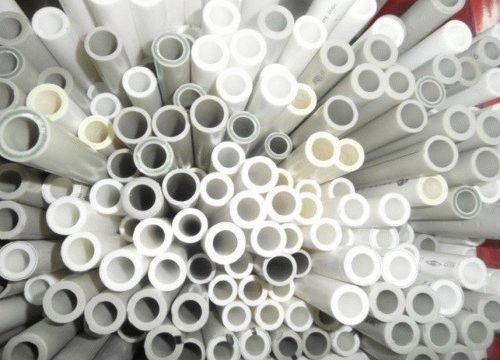

The photo shows plastic products for communication systems.
Docking with fittings
With this option, a set of shaped parts is used that allow combining not only two, but also more elements. Every developer who does not have a soldering machine at his disposal wants to learn how to connect plastic pipes in this way.
- The low cost of fittings allows you to reduce the cost of supplying communications.
- Ease of installation makes it possible to dock even for non-professionals.
- The ability to use parts in pressurized systems expands the range of applications.
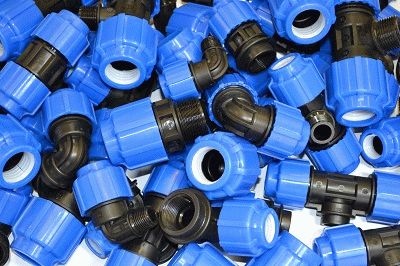

This is how the connection fittings look.
Note! It should be borne in mind that this method is applicable for elements with a small diameter, and in other situations, it is the joint with thermal action that is more often used.
It's time to understand how plastic pipes are connected directly with crimp fittings. From the tools you will need: a sharp knife for cutting elements, a calibrator, as well as manual or automatic pliers for performing the clamping operation.
First of all, the cutting of the components of the communication system is performed, if required in a particular case. The incision should be made strictly perpendicularly so that bevels and other imperfections do not form. After that, using a calibrator, ovality is eliminated at the junction.
Next, a special coupling is thrown, and the fitting itself with O-rings is inserted into the pipe. From above, crimping with prepared pliers is carried out. Thus, it is possible to dock the plastic elements.


An illustrative example of a compression fitting installation.
However, in some cases, you need to know how to connect a plastic pipe to a cast iron one. For this, a special adapter is used, the side diameter of which corresponds to the dimensions of the pipes used. In the process of joining, it must be remembered that the coefficients of linear expansion of plastic and cast iron are noticeably different.
Bonding of individual elements
In addition to the above option, there are other ways to connect plastic pipes. One of these is the bonding process, when the ends of the component parts are joined using a special chemical composition. In the course of work, it is possible to ensure sufficient tightness.
The principle of the composition
Adhesive designed for plastic products usually contains polyvinyl chloride, which dissolves in methyl ethyl ketone, tetrahydrofuran and cyclohesanone. Special adhesion additives are also added to two-component formulations.
A widely used compound.
Advantages of the glue method
- Quality grip chemical agent with the surfaces of the elements allows you to obtain high tightness.
- Availability the main material makes it possible to apply it to a wide range of consumers.
- The invisibility of the joint has a positive effect on the aesthetic perception of the components of the communication system.
Attention! The adhesive used must be kept at a sufficient distance from open flame, as it can easily catch fire. In addition, during work it is necessary to protect the skin from the ingress of the substance.
You can do the gluing with your own hands. Work should be carried out at temperatures from +5 to +35 degrees. In advance, you need to prepare a brush with natural bristles. In most cases, it comes directly with an adhesive.
Before starting the main steps, it is advisable to assemble the structure without the use of a chemical agent in order to perform a preliminary fitting. Before applying the substance, the surface must be degreased using solvents.


The process of applying glue is demonstrated.
A thin layer of glue is applied to the prepared surfaces. The plastic product is inserted into the hole until it stops, while rotation or other manipulations must be avoided. The components are held for 15-20 seconds so that the adhesive has time to dry.
Flaring
The presented method is applicable mainly for sewer systems, since they do not create pressure. At the ends of the elements used, there are special connections for plastic pipes - sockets. With their help, the fixation itself is made.
Positive aspects of technology
- The relatively high assembly speed ensures that the assembly is carried out as soon as possible.
- The absence of the need to purchase additional components allows you to reduce costs.
- The possibility of self-assembly eliminates the need for professional help.
Docking principle: 1 - socket, 2 - seal.
Important! For non-pressure systems, this option can be considered sufficiently tight, because when installed, a rubber gasket is inserted inside, which at the same time makes it possible to compensate for the mismatch of the parts to be connected.
Description of the assembly process
After making sure before installation that there is a rubber ring in the socket, you need to clean it from various contaminants, then you will be able to achieve good adhesion. A lubricant should be applied to the smooth pipe edge to improve the seal. After that, docking is carried out.
For this, the smooth end of the element is wound into the socket until it stops. The place of contact with the edge is marked with a marker to make it easier to determine the distance of the docking. Further, the product is pulled back about 10 mm directly from the line.
The gap made is needed to compensate for linear expansion, which usually occurs during temperature fluctuations. In this regard, it will be possible to avoid the appearance of internal stresses in the communication network.
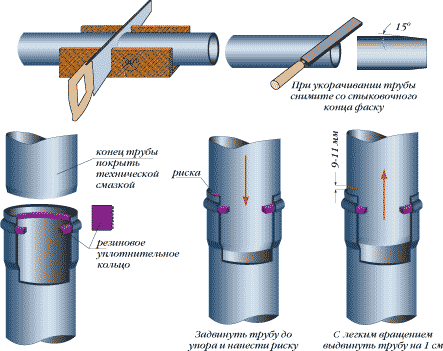

Highlights with a socket joint.
System components are cut strictly perpendicularly to eliminate the possibility of bending in the piping. After cutting, the chamfer is removed from the end using a conventional file. This reduces the likelihood of damage to the gasket.
We connect a new toilet to a cast iron pipe
All details of the process will depend on how the drains are displayed:
- Vertical release. Installation is elementary, the main difficulties are in choosing a toilet model suitable for your conditions. The connection must be carefully sealed to prevent the spread of odor. For this purpose, it is optimal to use a rubber cuff.
- Horizontal release. For the most part, a similar design is found in imported toilet bowls. It is most appropriate to purchase these models in case of complete replacement of systems or their installation "from scratch". The connection is not difficult - you only need a corrugated hose.
- Oblique release
In this case, the outlet pipe of the toilet to be connected is connected to the inlet pipe. Pay particular attention to sealing and sealing.
Having carefully studied the nuances, you will learn how to properly connect sewer pipes made of various materials. Since their installation will not be difficult, even not the most experienced home craftsman will master it, which will significantly reduce the upcoming costs.
